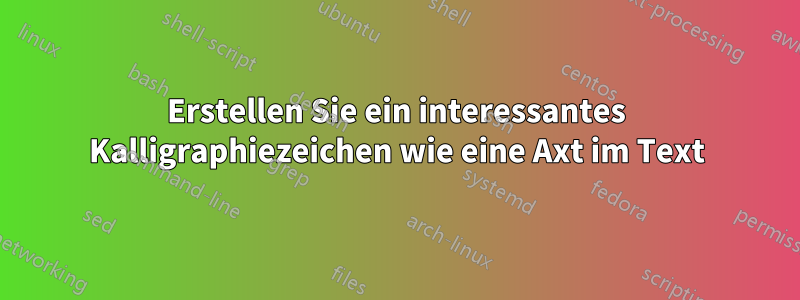
Ich versuche, LaTex/PDFTex zu verwenden, um dieses Zeichen (oder zumindest diese Abbildung) in den Text einzufügen.
Ich konnte keinen passenden Charakter wie diesen finden:
Gibt es eine Möglichkeit, dieses Symbol zu finden oder es als Zeichen wie das englische Alphabet zu erstellen, sodass wir es in LaTex eingeben können?
Antwort1
Zumindest eine Zahl mit TikZ ist:
\documentclass{article}
\usepackage{tikz}
\begin{document}
\begin{tikzpicture}
\fill[black] (-0.9,7.1) -- (-4.8,6.79)
-- (-0.72,6.26) -- (-0.71,4.81)
-- (-0.94,3.78) -- (-5.69,3.73)
-- (-0.65,2.96) -- (-0.7,-5.6)
.. controls (-0.78,-5.82) and (-0.74,-6.04)
.. (-1.02,-6.31) .. controls (-1.29,-6.37) and (-1.5,-6.48)
.. (-2.1,-6.27) .. controls (-2.8,-5.98) and (-3.45,-5.43)
.. (-3.92,-4.81) .. controls (-4.32,-3.6) and (-4.38,-2.9)
.. (-4.36,-2) .. controls (-4.12,-0.24) and (-2.85,0.63)
.. (-2.5,1.4) .. controls (-3.8,1.1) and (-4.22,0.5)
.. (-4.74,-0.7) .. controls (-5.32,-2.05) and (-5.47,-3.2)
.. (-4.84,-4.6) .. controls (-4.6,-5.2) and (-4.23,-5.7)
.. (-3.31,-6.47) .. controls (-2.16,-7.14) and (-1.5,-7.19)
.. (-0.3,-7.2) .. controls (1,-7.15) and (1.91,-7.14)
.. (2.8,-6.46) .. controls (3.81,-5.56) and (4.1,-4.7)
.. (4.35,-4.2) .. controls (4.7,-3.3) and (4.88,-2.11)
.. (4.5,-1.1) .. controls (4.18,-0.24) and (3.7,0.41)
.. (3.24,0.9) .. controls (2.8,1.25) and (2.48,1.37)
.. (1.94,1.61) .. controls (2.88,0.29) and (3.56,-0.75)
.. (3.81,-1.6) .. controls (4.09,-2.97) and (3.72,-4.18)
.. (2.86,-5.18) .. controls (2.46,-5.67) and (2.4,-5.78)
.. (1.76,-6.06) .. controls (1.06,-6.51) and (0.6,-6.5) .. (0.2,-6.3)
.. controls (0.19,-3.59) and (0.16,-1.8)
.. (0.28,3.06) -- (5.26,3.4)
-- (0.22,3.97) -- (0.2,6.25)
-- (4.54,6.68) -- (2.39,6.99) -- cycle;
\end{tikzpicture}
\end{document}
Hinzufügen. Eine symmetrischere Abbildung könnte sein:
\documentclass{article}
\usepackage{tikz}
\begin{document}
\begin{tikzpicture}
\coordinate (s0) at (0,7.15);
\coordinate (s1) at (-4.6,6.8);
\coordinate (s12) at (4.6,6.8);
\coordinate (s2) at (-0.5,6.3);
\coordinate (s11) at (0.5,6.3);
\coordinate (s3) at (-0.5,4);
\coordinate (s10) at (0.5,4);
\coordinate (s4) at (-5.4,3.4);
\coordinate (s9) at (5.4,3.4);
\coordinate (s5) at (-0.5,3);
\coordinate (s8) at (0.5,3);
\coordinate (s6) at (-0.5,-6.2);
\coordinate (s7) at (0.5,-6.2);
\fill[black] (s0) -- (s1) -- (s2) -- (s3) -- (s4) -- (s5) -- (s6)
.. controls (-4.9,-6.5)
and (-5,-0.9) .. (-2.3,1.4) .. controls (-6.5,-0.9)
and (-5.7,-7.1) .. (0,-7.1) .. controls (5.7,-7.1)
and (6.5,-0.9) .. (2.3,1.4) .. controls (5,-0.9)
and (4.9,-6.5) .. (s7) -- (s8) -- (s9) -- (s10) -- (s11) -- (s12) -- cycle;
\end{tikzpicture}
\end{document}
Antwort2
Eine Möglichkeit besteht darin, das Bild (Xsney.png) zu speichern und dann ein Makro zu erstellen. Wenn Sie ein wenig mit den Abständen herumspielen, sieht es ok aus. Beachten Sie das \nach dem Makroaufruf, wenn Sie nach dem Symbol ein Leerzeichen wünschen.
Hier ist der Code:
\documentclass{article}
\usepackage{graphicx}
\newcommand{\Xsney}{\hspace{-.1em}\raisebox{-.1ex}{\resizebox{1.8ex}{!}{\includegraphics{Xsney.png}}}\hspace{-.1em}}
\begin{document}
I don't know what \Xsney\ means. O\Xsney O
{\Large I don't know what \Xsney\ means. O\Xsney O}
\end{document}
Antwort3
Du kannst :
- Konvertieren Sie Ihr PNG beispielsweise mit Inkscape in SVG.
- Verwenden Sie Ihr SVG, um eine benutzerdefinierte Schriftart zu erstellen mitFontello. Ich habe dem
OBuchstaben Ihr Symbol zugeordnet. - Verwenden Sie das
xseny.ttfin XeLaTeX definierte Attribut wie folgt:
\documentclass[varwidth,border=7pt]{standalone}
\usepackage{fontspec}
\newfontfamily{\Xseny}{xseny.ttf}
\begin{document}
\textbf{\textsf{Xseny symbol}} {\Xseny O}
\end{document}
Notiz :Diese Antwort folgt dem gleichen Workflow wieDieses hier.







